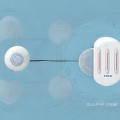As an athlete, you understand the importance of taking care of your body. Whether you’re a runner, a weightlifter, or anything in between, muscle recovery is key to maintaining peak performance. A muscle roller stick can be a powerful tool in your recovery arsenal, allowing you to ease soreness, reduce inflammation, and increase flexibility. In this article, we’ll explore the benefits of using a muscle roller stick, including the science behind muscle recovery, the different types of rollers available, and how to use them effectively.
Understanding the Science Behind Muscle Recovery
Before diving into the benefits of a muscle roller stick, it’s important to understand the basics of muscle recovery. Exercise — especially high-intensity exercise — causes microscopic damage to muscle fibers. This damage, called microtears, initiates a series of healing processes that ultimately strengthen and rebuild the muscle. However, these processes also lead to inflammation, soreness, and reduced range of motion. To optimize recovery, you need to reduce inflammation, improve blood flow to the affected areas, and increase flexibility. A muscle roller stick can help with all of these goals.
One important aspect of muscle recovery is proper nutrition. Consuming enough protein is essential for muscle repair and growth. Additionally, staying hydrated is crucial for flushing out toxins and aiding in the delivery of nutrients to the muscles. It’s also important to consume enough carbohydrates to replenish glycogen stores, which are depleted during exercise. By fueling your body with the right nutrients, you can enhance your muscle recovery and improve your overall performance.
What is a Muscle Roller Stick and How Does it Work?
A muscle roller stick, sometimes called a massage stick or a foam roller stick, is a long, cylindrical tool that you roll over your muscles. They typically have an inner plastic or metal rod, with foam or rubber padding around the outside. Muscle roller sticks work by using pressure and friction to break up knots in the muscle fibers, promoting blood flow, and reducing inflammation. They can also help loosen tight fascia (connective tissue) around the muscle, allowing for greater range of motion and flexibility.
Using a muscle roller stick before and after exercise can help prevent injury and aid in recovery. By using the roller stick to warm up your muscles before a workout, you can increase blood flow and flexibility, which can help prevent strains and sprains. After a workout, using the roller stick can help reduce muscle soreness and speed up recovery time by increasing blood flow and reducing inflammation. Incorporating a muscle roller stick into your fitness routine can be a great way to improve overall muscle health and performance.
Types of Muscle Roller Sticks and Their Features
There are a wide variety of muscle roller sticks to choose from, with different features and price points. Some of the most common types include:
- Foam roller sticks: These are the most basic type, with a simple foam exterior and a solid inner rod. They’re affordable and effective for most people, but may not be durable enough for heavy use.
- Textured roller sticks: These have bumps or ridges on the exterior, providing deeper pressure for more intense muscle release. They can be more expensive but may be worth it for athletes with deep knots or chronic tension.
- Vibrating roller sticks: These have a built-in vibration function, which provides an extra level of massage and can help improve circulation. They tend to be the most expensive but may be worth the investment for serious athletes or those with chronic pain.
It’s important to consider the length and diameter of the roller stick when choosing one. Longer sticks are better for larger muscle groups, while shorter sticks are more versatile and can be used on smaller areas like the arms and calves. Additionally, thicker sticks provide more pressure and are better for deep tissue massage, while thinner sticks are better for lighter massage and general muscle maintenance.
Step-by-Step Guide on How to Use a Muscle Roller Stick for Recovery
Once you’ve chosen your muscle roller stick, it’s important to use it safely and effectively. Here’s a step-by-step guide:
- Select the muscle group you want to target, and prepare by stretching lightly.
- Position the roller stick under the muscle, and gently roll back and forth, using your own body weight to apply pressure.
- Focus on areas of tension or knots, spending extra time rolling over those spots for deeper massage.
- Roll for 1-2 minutes per muscle group, and repeat as needed.
- Finish with more stretching and hydration to replenish the body.
The Best Times to Use a Muscle Roller Stick for Maximum Effectiveness
To get the most out of your muscle roller stick, it’s important to use it at the right times. The ideal times to roll are:
- Before a workout: Rolling can warm up the muscles, increase blood flow, and reduce the risk of injury.
- After a workout: Rolling can reduce inflammation and soreness, and promote faster recovery.
- On rest days: Rolling can help keep muscles loose and prevent stiffness or excessive tightness.
Muscle Groups that Benefit Most from Using a Muscle Roller Stick
While you can use a muscle roller stick on any muscle group, some areas tend to benefit the most from rolling:
- Calves: Rolling can help loosen tightness in the calf muscles, especially for runners and other athletes who put a lot of stress on this area.
- Quads: Rolling can help with knee pain or tightness by releasing tension in the larger quadricep muscles.
- Back: Rolling can help with posture and spinal alignment by releasing tightness and knots in the muscles surrounding the spine.
How to Choose the Right Density of Foam Rolling for Your Needs
Different muscle roller sticks have different levels of density, which can affect how intense the massage is. Softer rollers are better for beginners or those with more sensitive muscles, while firmer rollers can provide a deeper release. It’s important to choose a foam density that works for your body and your goals, and to listen to your body as you roll.
Combining Other Techniques with Muscle Roller Stick to Improve Recovery Time
While muscle roller sticks can be incredibly helpful for recovery, they’re not the only tool in your arsenal. Combining other techniques like stretching, massage, and icing can help you recover even faster. You can also try using heat or cold therapy alongside rolling, depending on your needs.
Common Mistakes to Avoid When Using a Muscle Roller Stick for Recovery
Finally, it’s important to be aware of common mistakes you may make when using a muscle roller stick. These include:
- Rolling too aggressively: Use your own body weight to apply pressure, rather than forcing the roller stick into your muscles.
- Skipping warm-ups or stretching: Rolling is most effective when combined with other pre- and post-workout techniques.
- Using the roller stick on an injury: If you have an acute injury, like a muscle strain or sprain, always consult a healthcare professional before using a roller stick.
Conclusion
In conclusion, a muscle roller stick can be a fantastic tool for anyone looking to improve their muscle recovery time. By understanding the science behind muscle recovery, choosing the right roller stick, and using it safely and effectively, you can reduce inflammation, improve flexibility, and ultimately achieve your fitness goals faster and with less pain.





